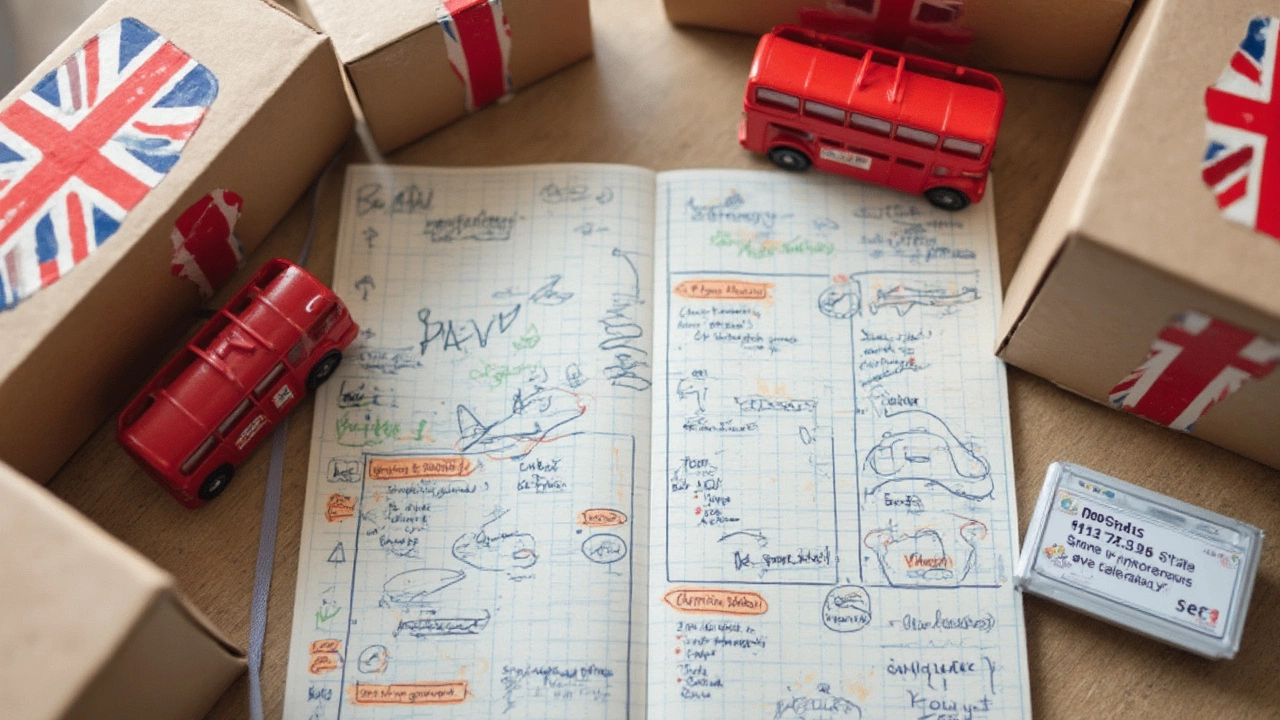If you’ve ever looked into shipping something overseas—whether it’s a giant crate or a box of T-shirts—the sticker shock is real. Costs pile up from every angle and it’s not just about distance; it’s packaging, customs, hidden fees, and a sprinkle of mystery charges that seem to come out of nowhere.
The good news: there’s almost always a cheaper way. The trick is knowing which shipping mode to pick, how to pack smart, and what digital tools can quickly sniff out deals. You don’t have to be a logistics pro to slash your bill—you just need a bit of guidance and a few clever tips. That’s what we’ll cover right here, sticking to things you can actually use, no fancy jargon needed.
- Why Shipping Costs Add Up Fast
- Sea Freight vs. Air Freight: The Real Price War
- Saving on Packaging and Consolidation
- Tech That Cuts Costs: Online Freight Marketplaces
- Smart Negotiation and Hidden Cost Traps
Why Shipping Costs Add Up Fast
Ever wondered why international shipping sometimes feels like highway robbery? It’s not just about moving your stuff from point A to point B—there are layers to what goes into that final price tag.
First, every shipment gets hit with a bunch of fees and charges, some obvious, others sneaky. Things like fuel costs, terminal handling, customs clearance, documentation, plus port and security charges all stack up. If you’re shipping by air, you’ll usually pay more than by sea, but you also save time. Either way, those extra charges sneak in.
Distance is only part of the equation. Here’s a reality check: a 2023 survey showed the average cost to ship a 40-foot container from Shanghai to Los Angeles was about $1,500. But wait—just one year earlier, it was a mind-blowing $10,000 because of global supply chain chaos. Prices swing based on fuel rates, seasonal demand, and world events.
Weight and size matter big time. Carriers charge based on either the actual weight or the "dimensional weight" (basically, how much space your stuff hogs). Bigger or awkward-shaped packages often mean higher bills, even if they’re not heavy.
Packing choices play a role too. Fragile goods need padding and double-wrapping, which adds to the size, driving up costs. Sometimes people ignore this, cram, and end up paying for “oversized” fees at the last moment.
Let’s break down some of the main cost drivers for international shipping:
- Transportation mode (sea, air, rail, truck)
- Fuel and surcharges (which change often)
- Handling fees at ports and airports
- Customs duties and taxes (which depend on the goods and destination)
- Insurance, especially for high-value or risky items
- Storage fees if shipments get delayed at ports
Here’s a quick look at some typical charges:
| Cost Element | Typical Range (USD) |
|---|---|
| Sea Freight (40' container, Asia-US West Coast) | $1,500 - $10,000 |
| Air Freight (per kg, Asia-US) | $2 - $6 |
| Port Handling Fee | $300 - $500 |
| Customs Clearance | $50 - $150 |
| Insurance (per $1,000 of goods) | $5 - $15 |
The punchline? Shipping isn’t just one flat rate. The mix of transport, paperwork, packaging, and surprise fees all make the final cost pile up before you know it. So if the price looks suspiciously low at first, double-check for those "extras" waiting to show up.
Sea Freight vs. Air Freight: The Real Price War
If you’re hoping to save cash on international shipping, the biggest decision is sea freight or air freight. It sounds simple, but the differences in cost, speed, and rules are pretty dramatic.
Let’s break it down. Sea freight—the classic container ship method—works great for large, heavy loads that don’t need to rush. It’s the slow and steady option. On the flip side, air freight is best for getting small, urgent shipments through fast, but you’re going to pay premium rates. The choice comes down to your budget and your timeline.
| Shipping Method | Avg. Cost (per kg) | Avg. Transit Time | Best for |
|---|---|---|---|
| Sea Freight | $0.50 - $2.00 | 20-40 days | Large, non-urgent shipments |
| Air Freight | $4.00 - $8.00 | 3-7 days | Small, urgent shipments |
Here are the pros and cons in plain English:
- Sea Freight Pros: It’s way cheaper if you’re sending a lot. There’s room for almost anything—cars, machinery, piles of boxes. It’s also easier on the planet.
- Sea Freight Cons: It’s slow, sometimes painfully so. Weather or port backups can drag things out for weeks. Tracking isn’t as detailed as air freight.
- Air Freight Pros: Speed is the big win. Even perishable stuff gets there safe. It’s simple to track—a major win if your customer is impatient.
- Air Freight Cons: Your wallet will feel it, and there are tough size and weight limits. Some goods (like batteries or certain chemicals) are restricted.
Don’t forget the hidden fees. Both methods hit you with extras like terminal charges, customs clearance, and insurance. Always ask for a full door-to-door quote before you make a choice. Pro tip: sometimes a mix makes sense—fast, small items by air, bulk goods by sea. That way you balance cost and speed for the best of both worlds.

Saving on Packaging and Consolidation
It’s easy to forget how much your packaging choices can mess with your bottom line. Every extra centimeter gets measured, and every wasted ounce can add dollars. Most carriers—including big names like FedEx and DHL—use dimensional weight pricing, so your box size can matter even more than its actual weight.
Here are a few straight-up money-saving hacks:
- Use custom-sized boxes or adjustable packaging to fit your goods snugly. Empty space is not your friend—it bumps up your shipping class and price.
- Go light but strong. Instead of piling on cardboard and padding, use bubble mailers, poly bags, or strong tape to cut down on weight without risking damage.
- Reuse materials, but don’t compromise safety. Many shippers—especially small businesses—cut costs by reusing boxes from suppliers, just double-check the boxes are solid and clean for customs inspection.
Consolidation is another straight-up game-changer, especially for international shipping. Instead of sending five small boxes on different days, combine them into one big shipment. Freight forwarders and shipping agents can do this for you and even group your parcel with other customers’ shipments. This is called Less-than-Container Load (LCL) for ocean freight and can slice your cost by half or more compared to sending air.
- If you use a freight forwarder, ask about regular consolidation schedules between your main ports.
- Find out if your products qualify for palletizing—putting smaller cartons on a single pallet—to get better rates for bulk moves.
- Whenever possible, plan ahead and wait until you can fill a larger container. The price per kilogram plummets with higher volume.
Combining smart packing with clever consolidation makes a massive difference. To max out cost efficient shipping, talk directly with your carrier or logistics provider before you even start packing—they’ll know what options are best for your shipment size, shape, and destination.
Tech That Cuts Costs: Online Freight Marketplaces
If you haven’t tried an online freight marketplace yet, you’re missing out on one of the fastest ways to save money with international shipping. Think of it like booking a flight online—except, instead of finding a seat to Paris, you’re letting dozens of shipping companies compete to carry your cargo. It brings prices out into the open, so you see real-time quotes and can compare in seconds instead of days.
Platforms like Freightos, Flexport, and ShipBob have become game-changers. Freightos, for example, claims users can save up to 40% by comparing rates this way instead of calling brokers or chasing random emails. That’s not small change—especially if you ship multiple times a year. These sites give you instant options for air, sea, and sometimes rail or road. You get filters for delivery speed, insurance, pickup, and even reviews from other shippers.
Here’s how to get the most out of these tools:
- Always compare multiple quotes before you book anything. Even a few minutes can save you hundreds.
- Look for “all-in” pricing options. These bundle things like fuel surcharges, customs handling, and port fees so you don’t get nasty surprises later.
- Try their extra add-ons, like tracking or customs clearance help, but only if the price checks out.
- Double-check customer ratings for carriers. The cheapest option isn’t always the best if shipments arrive late or damaged.
- Sign up for alerts—sometimes, rates dip after you first look. Getting a quick heads-up can make all the difference.
One thing to watch out for: some digital freight marketplaces partner with specific carriers, which means you still might not see every deal out there. For huge shipments or odd-sized freight, you might need to reach out directly to niche carriers or local forwarders. But for most shipments, these platforms take out the guesswork and put the power back where it should be—with you.

Smart Negotiation and Hidden Cost Traps
Here’s the deal: most international shippers just accept the quote they’re given, but you really don’t have to. Carriers bake in extra wiggle room, so there’s space to shave off costs, especially if you’re moving more than just a handful of items. When it comes to international shipping, companies like Maersk and FedEx often allow room for negotiation if you know what to ask for. Things like lower fuel surcharges or bundled pricing can be on the table—and sometimes all you need to do is ask.
Watch out for extra fees—they add up fast. Common examples include documentation charges, customs brokerage fees, terminal handling charges, and "last mile" delivery surcharges. Forwarders and carriers might not mention these until you’ve committed. Always ask for an all-inclusive rate up front. If a rate sounds suspiciously low, double-check for what’s not included.
- Request a detailed breakdown of charges in writing. This lets you compare apples to apples between quotes.
- Ask if there are any seasonal surcharges—shipping costs can skyrocket during Chinese New Year or right before Black Friday.
- See if you can join a shipping alliance or co-load with other businesses in your area to qualify for bulk discounts. Sometimes even your chamber of commerce can connect you with others looking to split a container.
It’s smart to lock in rates when they’re low. In 2021, ocean container prices spiked three or four times their normal rate. If you’re shipping regular volumes, ask about contracts instead of spot rates. You’ll dodge nasty surprises if the market suddenly goes wild again.
One more pro tip: keep all your documentation organized. Missing or incomplete papers can trigger hefty customs penalties or courier storage fees. Just staying on top of details here can save you hundreds or even thousands of dollars per shipment.





